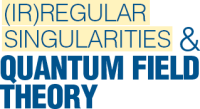On factorizable S-matrices, generalized TTbar, and the Hagedorn transition
Author(s)
Giancarlo Camilo, Thiago Fleury, Mate Lencses, Stefano Negro, Alexander Zamolodchikov
Topic
TTbar deformation
Abstract
We study solutions of the Thermodynamic Bethe Ansatz equations for relativis- tic theories defined by the factorizable S-matrix of an integrable QFT deformed by CDD factors. Such S-matrices appear under generalized TTbar deformations of integrable QFT by special irrelevant operators. The TBA equations, of course, determine the ground state energy E(R) of the finite-size system, with the spatial coordinate compactified on a circle of circumference R. We limit attention to the- ories involving just one kind of stable particles, and consider deformations of the trivial (free fermion or boson) S-matrix by CDD factors with two elementary poles and regular high energy asymptotics – the “2CDD model”. We find that for all val- ues of the parameters (positions of the CDD poles) the TBA equations exhibit two real solutions at R greater than a certain parameter-dependent value R∗, which we refer to as the primary and secondary branches. The primary branch is identified with the standard iterative solution, while the secondary one is unstable against it- erations and needs to be accessed through an alternative numerical method known as pseudo-arc-length continuation. The two branches merge at the “turning point” R∗ (a square-root branching point). The singularity signals a Hagedorn behavior of the density of high energy states of the deformed theories, a feature incompatible with the Wilsonian notion of a local QFT originating from a UV fixed point, but typical for string theories. This behavior of E(R) is qualitatively the same as the one for standard TTbar deformations of local QFT.
Year
2021
Reference
Camilo, Giancarlo, et al. “On factorizable S-matrices, generalized TTbar, and the Hagedorn transition.” Journal of High Energy Physics 2021.10 (2021): 1-37. doi=”10.1007/JHEP10(2021)062″

